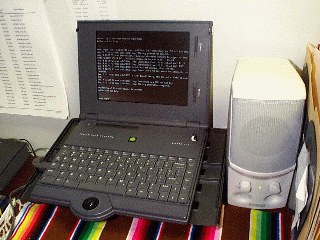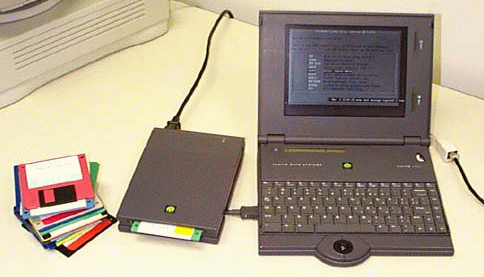
|
| Figure 1: Zenith Z-Lite 425L ("xena") running Linux 2.0.35 (from the Slackware 3.6 distribution). (The speaker is connected to a nearby desktop machine, not the laptop). |
Because the hard drive is so small (only 150MB) I don't run X11 on it, but with gpm I still have a functioning mouse (actually a trackball), and I use the screen program to provide multiple text windows. (You can do the same thing with Linux virtual consoles, but then you have to log in to each console window separately. I actually use both.)
| xena - Operating System and software | |
|---|---|
| Distribution | Slackware 3.6 |
| Kernel: | 2.0.35 |
| Window system: |
screen and/or Linux consoles, with gpm for mouse support. I don't run X11. |
| Installed Software: |
GNU Emacs 20.3.1,
perl 5.005_02 screen 3.7.2, ssh 1.2.26, pgp 2.6.2 tripwire 1.2, mush 7.2.6 beta(4) lynx, arpwatch, tcpdump, rdist, rsync |
Linux Installation
When I first found this machine it had been abandoned for several years. It was running Windows 3.1, and as a result it was so slow that it was next to useless.A colleague had just installed Slackware 3.4 on his home machine, and he still had the set of floppy disks he had created for that installation. So all I really had to do to install Linux was create the proper boot disk (bare.i) and root disk (pcmcia.gz). One can download the boot and root disk images from The Slackware Linux Project. After booting from the boot disk all one really has to do is read the instructions as they are presented and feed in the other disks as called for.
|
If you don't want to make a stack of 20 or 30 floppy disks to install Linux there is another way to do it. Once you have installed the A disk series (core Linux) and N disk series (Networking) then you have enough to run as an NFS client. Put the rest of the packages to install (or the whole distribution) on another machine on a filesystem that is exported to the laptop. On the laptop run the setup program and for the software source select "NFS mounted filesystem". You will have to enter some basic network info, such as the IP address of the NFS server, but once you have the disk mounted via NFS it's very easy to install anything else you need (as long as you have room).
This is the same procedure I've used to upgrade, first from Slackware 3.4 to Slackware 3.5, and more recently to Slackware 3.6 (Linux 2.0.35 kernel). The one problem I had was that I tried to NFS export to the laptop a CD-ROM containing the full Slackware distribution. Exporting the CD directly didn't work, so in the end I had to copy the whole CD to a hard drive partition and export that partition via NFS to the laptop.
| Zenith Z-Lite 425L - Specifications | |
|---|---|
| Processor: | 80486SL (no math coprocessor) |
| Speed: | 25 MHz |
| Memory: | 6.4 MB |
| Hard Drive: | 162 MB (147MB w/ formatted ext2 filesystem) |
| Pointer Device: |
Litepoint IP-100 trackball which attaches at the front of the keyboard (see Figure 1). The type for gpm is "-t ps2". An external mouse can also be used. |
| Network Card: |
3Com Etherlink III LAN+33.6 PCMCIA card. 10Base-T ethernet and 33.6 Kbps modem. (3Com 3c562 chip - I use 3c589 driver.) |
| Floppy Drive: |
External 3.5" 1.44MB drive, which connects via side port and also provides power connection. |
| CD-ROM | None. (Might work with PCMCIA SCSI controller?) |
| Video Chip: | VGA, 256K memory. (I'm not running X11!) |
| Display: |
7 in. x 5.2 in.,
640x480 monochrome transmissive LCD (supports 64 shades of grey). |
| RTC battery: | Toshiba Lithium Battery CR2032 (3V) |
| Battery Pack: | Toshiba Ni-MH Battery Pack BA-1100 (8.4V, 2200mAh) |
| Sound: | None? (It does beep, but that's it so far.) |
| PCMCIA: | Two slots, side by side on rear bottom. |
| I/O ports: |
External PS/2 mouse connecetor.
Serial Port (RS-232C) configurable as "COM1" or "COM2". Parallel Printer port (DB-25) External video adapter (Horiz: 31.49 kHz, Vert: 57-60 or 70 Hz) |
| |||||||||||||||
| Figure 2: Rear view showing PCMCIA slots and I/O ports. | |||||||||||||||
Power Managment
From the BIOS one can select what happens when the power button is pressed or the lid is closed. The options are:
| Power Button: | Power ON/OFF Rest/Resume |
| Lid Open/Closed: | Rest/Resume Beep/Normal No Beep/Normal |
It seems doubtful that there is any chance that apm can control anything on this old thing.
Serial Port
The serial port on this machine can be used to direclty read data from laboratory devices such as a Multi-Channel Analyser (MCA). In the spring of 2003 I used this machine in the Vassar College Modern Physics Laboratory for data acquisition for an experiment to measure the lifetime of cosmic ray muons. Here are detailed instruction.
The following year we also used Dell desktop computers on wheeled carts, with UPS and wifi cards, for the same purpose, though this was a bit more awkward than using an old laptop.
Related Links:
- Linux on Zenith Z-Note-MX
- Linux on Zenith Z-Note 325L
- Linux on Laptops - Zenith
- Zenith Z-lite 425L Product Specs.
© Copyright 2000,2003 by Eric Myers

